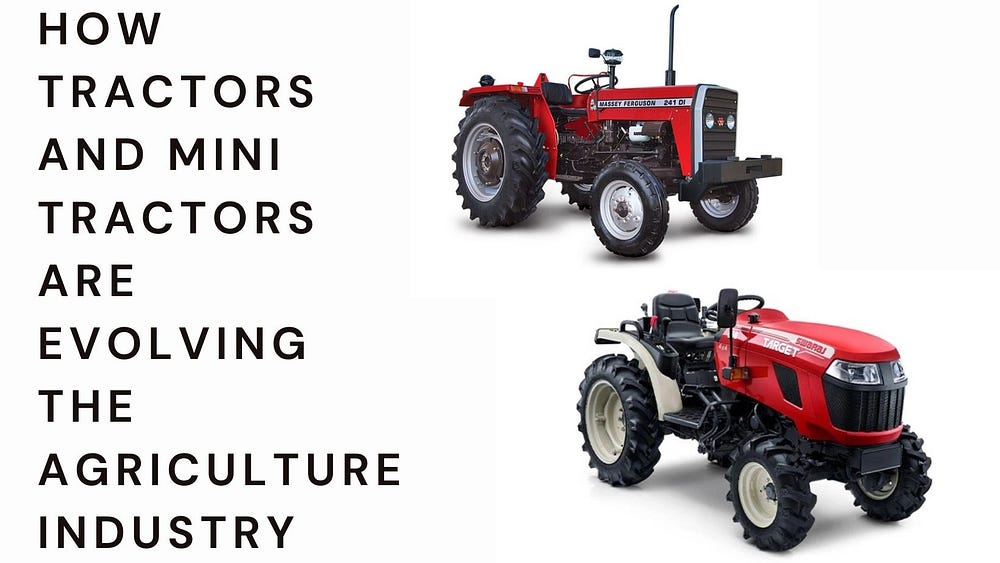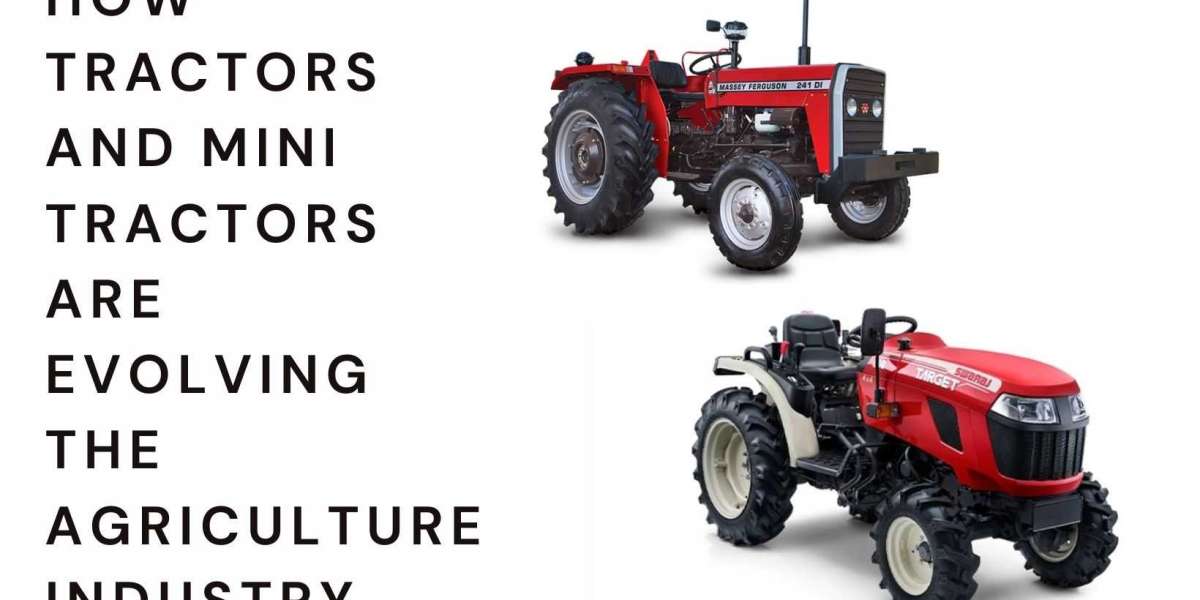Introduction
The agriculture industry has always been a cornerstone of human civilization, and as the global population grows, the demand for food production intensifies. One of the most influential factors driving efficiency and productivity in agriculture has been mechanization, especially through the use of tractors. Over the decades, tractors and, more recently, mini tractor, have revolutionized farming methods and enabled farmers to handle larger acreages with reduced labor. From large farms in industrialized nations to small-scale holdings in developing countries, tractor have dramatically altered the way we cultivate land, making farming less labor-intensive and more sustainable.
In this article, we will explore how tractors and mini tractors have evolved, their impact on agriculture, the latest technological advancements, and their role in sustainable farming.

1. Evolution of Tractors in Agriculture
1.1 History of Traditional Tractors
The journey of tractors in agriculture began in the early 20th century, marking a shift from manual and animal labor to mechanized farming. Traditional tractors were simple machines designed to pull heavy loads, helping farmers plow fields and transport materials more efficiently than with animal power alone. This innovation freed up labor, increased productivity, and allowed for the cultivation of larger tracts of land.
As technology advanced, tractors evolved to include engines with higher horsepower, which enabled them to take on more complex tasks like planting, tilling, and harvesting. The efficiency brought about by these machines helped usher in the Green Revolution, significantly boosting crop yields worldwide.
1.2 Advances in Tractor Technology
With each passing decade, tractors have incorporated new technologies, making them not only more powerful but also more versatile. Modern tractors now come equipped with high-tech features like GPS systems, which assist in precision agriculture, enabling farmers to plant crops with unprecedented accuracy. These technological improvements have streamlined farming processes and minimized waste, leading to cost savings and higher yields.
2. Rise of Mini Tractors in Small-Scale Farming
2.1 What Are Mini Tractors?
Mini tractors are compact, versatile machines that are particularly suited for small-scale farming. Unlike traditional tractors, mini tractors are lighter and easier to operate, designed to work efficiently on smaller plots of land. They are often powered by smaller engines, making them more fuel-efficient and cost-effective for farmers who don’t require the heavy horsepower of full-sized tractors.
Mini tractors are ideal for tasks like plowing, sowing, and transporting materials over short distances. They are also highly maneuverable, which makes them useful for navigating tight spaces and handling specific tasks in orchards, vineyards, and gardens.
2.2 Mini Tractors’ Popularity in Developing Regions
In many developing countries, the average farm size is much smaller than in industrialized regions. The affordability and utility of mini tractors have made them highly popular among small-scale farmers in these areas. As a more affordable option, mini tractors allow these farmers to adopt mechanization without the financial strain associated with larger tractors. Additionally, their easy handling and low maintenance requirements make mini tractors accessible to a broader demographic of farmers, contributing to the modernization of agriculture in regions where resources are limited.
3. Role of Tractors in Enhancing Productivity
3.1 Increased Efficiency in Field Work
Tractors are invaluable for increasing the efficiency of various farming operations. For instance, they can till a field in a fraction of the time it would take with manual labor. This increased speed enables farmers to complete planting and harvesting in shorter time frames, which is especially crucial when dealing with weather-dependent crops. In addition, tractors can be outfitted with specialized attachments for tasks like seed planting, fertilization, and pesticide application, all of which contribute to more productive and organized farming practices.
3.2 Reduction in Labor Costs
The use of tractors significantly reduces the reliance on manual labor, which translates to lower operational costs for farmers. By automating tasks such as plowing, planting, and harvesting, tractors reduce the need for large teams of farm workers. This not only decreases labor costs but also frees up human resources for other essential tasks. Furthermore, the tractor industry itself creates jobs in manufacturing, repair, and maintenance, contributing to local economies and providing support to the agriculture sector.
4. Technological Innovations in Tractors
4.1 GPS and Precision Agriculture
Modern tractors are often equipped with GPS technology, which plays a pivotal role in precision agriculture. By using GPS, farmers can map their fields, optimize planting patterns, and apply fertilizers and pesticides with pinpoint accuracy. This level of precision reduces waste and enhances crop productivity, as resources are applied only where needed. GPS-enabled tractors also allow for controlled traffic farming, where machinery follows predefined paths, preventing soil compaction and preserving soil health.
4.2 Autonomous and Smart Tractors
Automation in tractors is one of the most exciting advancements in agriculture today. Smart tractors equipped with AI and machine learning are capable of autonomous operation, meaning they can perform tasks with minimal human intervention. These tractors can operate around the clock, monitor crop health through sensors, and even make real-time adjustments based on data from the field. Autonomous tractors not only improve efficiency but also help address labor shortages in the farming industry.
4.3 Eco-Friendly Models and Electric Tractors
As the world moves towards sustainable practices, the agriculture industry is also adopting eco-friendly innovations. Electric tractors, for instance, produce no emissions, making them an ideal choice for farmers looking to reduce their carbon footprint. These tractors are quieter, reduce the reliance on fossil fuels, and lower the long-term costs associated with fuel. In addition, many modern tractors are being designed with hybrid power sources, further contributing to environmentally sustainable agriculture.
5. Tractors’ Role in Sustainable Agriculture
5.1 Resource Efficiency and Conservation
Tractors equipped with advanced technology help conserve valuable resources such as soil, water, and energy. With precision farming, tractors ensure that fertilizers and pesticides are applied only where needed, reducing chemical runoff and protecting the environment. Additionally, GPS and automation minimize soil compaction, preserving the soil structure and promoting healthier crop growth.
5.2 Organic Farming and Tractors
In organic farming, where chemical usage is minimal, tractors play a significant role in maintaining soil health. Specialized attachments enable tractors to cultivate soil and control weeds without the use of herbicides. By facilitating organic practices, tractors support the growing demand for sustainable and eco-friendly agriculture methods.
6. Mini Tractors and Specialty Farming
6.1 Utility in Diverse Farming Environments
Mini tractors have proven invaluable in specialty farming environments, where traditional, large tractors might be too cumbersome or powerful. Due to their compact size and agility, mini tractors can navigate tight spaces and handle rough terrains. This makes them ideal for small but high-value crops grown in confined or specialized plots, such as vineyards, orchards, and even greenhouses. Mini tractors perform critical tasks in these spaces, including soil preparation, harvesting, and transporting produce, all without disturbing delicate plant systems. Their light weight also prevents soil compaction, which can be a significant concern in these sensitive growing environments.
Farmers in hilly or mountainous regions also find mini tractors indispensable. Unlike larger machines that struggle on slopes or uneven terrain, mini tractors offer better maneuverability and stability. This versatility has helped expand agriculture to areas that were previously considered difficult for traditional farming, enabling better crop diversification and maximizing the use of available land resources.
6.2 Supporting Niche Markets
The rise in organic, hobby, and urban farming has created a market for smaller machinery that fits within unique farming practices. Mini tractors allow hobby and urban farmers to engage in efficient, small-scale agriculture right in backyards or community gardens. They support the growing demand for organic produce by facilitating non-chemical weeding and soil preparation, aligning well with the values of organic farmers. Additionally, mini tractors are often customizable, with various attachments designed for small and specialized tasks, making them ideal for niche farming setups.
7. Economic Impact of Tractors and Mini Tractors
7.1 Boosting Farmer Incomes
The economic impact of tractors and mini tractors extends beyond productivity improvements. By reducing the time and labor needed to perform essential agricultural tasks, tractors allow farmers to plant and harvest more crops within a season, thereby boosting yields. Increased productivity often translates to higher incomes, especially in markets where there is a demand for consistent and quality produce. For many small and medium-sized farmers, owning a tractor or mini tractor has become an investment that quickly pays off through increased efficiency and revenue.
Moreover, the affordability of mini tractors provides access to mechanization for farmers with limited budgets. By investing in these smaller machines, they can experience the benefits of mechanization without the financial burden of purchasing a larger tractor. This accessibility enhances farmers’ economic resilience, allowing them to scale their operations incrementally and respond to market demands more effectively.
7.2 Financing Options and Government Support
To encourage the adoption of tractors and mini tractors, many governments and financial institutions offer subsidies, grants, and low-interest loans to farmers. These financing options aim to lower the barriers to mechanization, particularly for smallholders. In countries with large agricultural sectors, government programs may provide additional incentives for purchasing eco-friendly tractors or electric models, supporting both economic growth and environmental objectives.
Government-backed programs also sometimes include training and support for maintenance, ensuring that farmers can effectively operate and care for their equipment. These initiatives help create a more sustainable farming economy by fostering long-term improvements in productivity and profitability.
8. Challenges in Adopting Tractor Technology
8.1 High Costs of Advanced Models
While tractors and mini tractors bring undeniable benefits, the initial investment can be prohibitive, especially for small and medium-sized farmers. High-tech models equipped with the latest features, such as GPS or automation, come with a premium price tag. This cost barrier can be challenging in developing countries, where access to affordable technology is crucial for sustaining agricultural productivity. Additionally, the rapid pace of innovation means that older tractor models may become obsolete quickly, potentially reducing their long-term value.
For many farmers, balancing the need for efficient machinery with the cost of purchase is a major challenge. Financing options and cooperative ownership models — where multiple farmers share a single tractor — are some solutions that can help bridge this gap, though these arrangements may not be accessible to all farmers, particularly those in remote or underserved areas.
8.2 Lack of Infrastructure for Maintenance
Maintenance infrastructure for tractors, particularly in rural areas, is often inadequate, affecting the long-term usability of the machinery. Access to replacement parts, skilled mechanics, and maintenance facilities can be limited, leading to downtime and costly repairs. For farmers, particularly in remote regions, the lack of readily available repair services can turn a mechanical issue into a significant disruption in farming operations. As a result, some farmers may hesitate to invest in new tractors, fearing that maintenance difficulties will offset the benefits.
To address this, there is a growing need for decentralized maintenance support and training programs that can equip local mechanics with the skills needed to service tractors. By building local capacity for repairs and maintenance, rural areas can support tractor adoption and ensure that farmers experience the full benefits of their investment.
9. Future Trends in Tractor Technology
9.1 AI and IoT in Tractors
Artificial intelligence (AI) and the Internet of Things (IoT) are transforming tractors into “smart” machines capable of gathering data, analyzing conditions, and making decisions in real-time. Smart tractors are outfitted with sensors that monitor soil health, moisture levels, and crop growth, feeding this information back to farmers via mobile apps or control panels. By analyzing data from these sensors, AI systems can suggest optimal planting and harvesting times, recommend precise fertilizer applications, and even detect pests before they become a significant threat.
IoT connectivity also enables tractors to communicate with other farm equipment, creating a coordinated, efficient farming environment. For example, tractors can work alongside drones that monitor crop health from above, providing comprehensive data that aids in decision-making. These advancements not only streamline farming operations but also help farmers make environmentally conscious choices, using resources efficiently and minimizing waste.
9.2 Expansion of Electric and Hybrid Models
As the agriculture industry moves towards sustainable practices, the demand for electric and hybrid tractors is increasing. Electric tractors reduce dependency on fossil fuels, lower operating costs, and reduce emissions, all of which contribute to a greener farming environment. Many manufacturers are investing in battery technology that allows these tractors to operate for extended periods on a single charge, making them suitable even for larger farms.
Hybrid models, which combine electric and traditional fuel sources, offer an alternative for farmers who need the range of fuel-powered tractors but want to reduce their environmental impact. These tractors can switch between power sources based on the task at hand, optimizing both energy efficiency and power output. As battery technology continues to improve, electric and hybrid tractors are likely to become mainstream, marking a significant step towards sustainable agriculture.
9.3 Tractors for Vertical and Hydroponic Farming
With the rise of alternative farming methods like vertical and hydroponic farming, tractors are being reimagined to suit these unconventional spaces. Miniature tractors and robotic systems are being developed for indoor farms, where crops are grown in stacked layers or nutrient-enriched water. These compact machines can navigate tight spaces and automate tasks such as planting, nutrient distribution, and harvesting, all within a controlled environment.
As vertical and hydroponic farming grow in popularity, especially in urban areas, tractors adapted to these settings will play a key role in urban food production. These innovations signify how tractor technology can evolve to support diverse farming methods, helping meet the global food demand in both traditional and non-traditional agricultural spaces.
Conclusion
Tractors and mini tractors have undeniably transformed the agriculture industry, making it more efficient, sustainable, and capable of meeting the demands of a growing population. From their early beginnings as simple machines to today’s high-tech, eco-friendly, and even autonomous models, tractors have become an essential tool for farmers worldwide. Mini tractors, in particular, have democratized mechanization, offering small and medium-sized farmers a way to increase productivity without the high costs associated with larger machines.
As technology advances, we can expect tractors to become smarter, more environmentally friendly, and adaptable to various farming environments. These machines will continue to play a critical role in promoting sustainable farming practices, conserving resources, and helping farmers improve yields and profitability. In a world where agriculture faces significant challenges, from climate change to resource scarcity, tractors and mini tractors stand as powerful tools driving the future of farming.
FAQs
1. How have tractors improved productivity in agriculture? Tractors have significantly boosted productivity by mechanizing essential farming tasks like plowing, planting, and harvesting. This mechanization allows farmers to complete work faster, with less labor and higher precision, leading to better crop yields.
2. What are the benefits of mini tractors for small-scale farmers? Mini tractors are affordable, fuel-efficient, and easy to operate, making them ideal for small-scale farmers. They allow farmers to access mechanization without the high costs associated with larger tractors, improving productivity and profitability on small plots of land.
3. What is the role of AI and IoT in modern tractors? AI and IoT enable smart farming by providing real-time data on soil, crop health, and weather. Modern tractors equipped with these technologies can make data-driven decisions, optimizing planting, watering, and harvesting for better yields and resource efficiency.
4. Are electric tractors a viable option for sustainable agriculture? Yes, electric tractors offer a sustainable alternative by reducing emissions and dependency on fossil fuels. They are quieter and more cost-effective over time, making them an attractive option for eco-conscious farmers aiming to reduce their environmental impact.
5. How do government programs support tractor adoption? Many governments offer subsidies, grants, and low-interest loans to help farmers purchase tractors. These programs aim to make mechanization more accessible, especially for small farmers, thus enhancing agricultural productivity and supporting economic growth in the farming sector.







